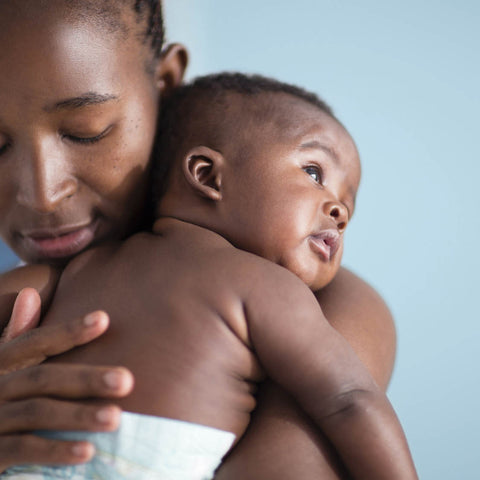Preemie Skin-to-Skin: Ages and Stages
Today, most hospitals facilitate immediate skin-to-skin for all preemies born after 32 weeks, as long as they’re medically stable and even if they need breathing support.
Skin-to-skin (STS) is encouraged even before 32 weeks, though you may have to be careful (the great NICU nurses will help you!).

Skin-to-Skin (STS) Time is Also Called
"Kangaroo Care"
Preemies and very young babies benefit immensely from skin-to-skin contact. The first hour after birth is often referred to as the “magical hour” for all of the amazing developments that take place when baby is placed on mom’s chest.
Numerous studies have shown that preemies, especially, gain from this bonding time with mom.
Even if you had a Cesarean section or your baby was born prematurely, it’s still important to have as much skin-to-skin contact with your little one as possible.
Simply holding your baby torso-to-torso can help regulate their breathing, body temperature, and pulse, as well as helping you both relax. Body temperature regulation can be especially challenging for preemie babies, and Kangaroo Care can make a big difference.

STS time with your baby has been shown to correlate with higher rates of breastfeeding success, too.
This close contact after birth also gives your baby a chance to be colonized by the same bacteria as mom (your "microbiome").
This colonization—combined with breastfeeding’s immunity-boosting advantages—can help prevent allergic reactions as your baby gets older, and has proven to help a baby resist hospital-acquired infections.
Sometimes, premature babies who are put into incubators are populated with microbes in their skin and gut different from that of their mother’s. In the NICU, your touch on your preemie’s little back or arm or foot not only signals “Mommy’s here,” it introduces your microbiome.
Using unscented, naturally-derived skin care products like BEB Organic Nurturing Oil on yourself and your baby during these first few days will help baby recognize your unique scent when you two are cuddling.

Touch Time With Infants and Toddlers
As your baby grows into an infant and then a toddler, their independence increases. This means less time spent in your arms and more time spent exploring the world around them.
But there’s still plenty of opportunity for you and baby to enjoy close contact beyond regular hugs and kisses!
Wearing your baby instead of using a stroller, enjoying bath time together, and cuddling up to read stories before bedtime are all easy ways to continue having skin-to-skin time together.
This is also a great time to start teaching personal care habits like proper hand washing.
Baby’s growing independence also means more exposure to the elements and germs. Try to keep his skin hydrated and protected with products like BEB Organic Silky Cream, Nurturing Oil, Bubbly Wash, Soothing Serum (formerly Healing Gel), and Diaper Balm.

Older Kids and Increasing Physical Connections
Although your child is most likely too big to carry around or even fit in the bathtub with you, you can still benefit from STS contact in other ways.
Holding hands, back tickles during a bedtime tuck-in, high fives or fist bumps, even a game of thumb wrestling is great way to maintain a high level of physical contact with your child. While it isn’t the classic version of skin-to-skin, this casual touch still comes with a long list of physiological benefits.
Bath-time becomes a “teachable moment” for kids to learn how to take care of some of their own grooming but still allows you close contact as you help them wash up. Try spending a few minutes snuggling together in a big fluffy towel before pajama time.
This is also a terrific opportunity to create a personal care routine for your child that includes care for the environment – limiting the use of resources like water, paper and energy and using products that reduce exposure to chemicals.
Sources
- Lozoff B, Brittenham GM, Trause MA, Kennell JH, Klaus MH. The mother-newborn relationship: limits of adaptability. J Pediatr 1977 July;91(1):1-12.
- Schore AN. Effects of a secure attachment relationship on right brain development, affect regulation, and infant mental health. Infant Mental Health Journal 2001;22(1-2):7-66.
- Mori R, Khanna R, Pledge D, Nakayama T. Meta-analysis of physiological effects of skin-to-skin contact for newborns and mothers. Pediatrics International 2010; 52(2): 161-170
- 2008 July; 115(8): 1037–1042. The natural caesarean: a woman-centred techniqueJ Smith,a F Plaat,b and NM Fiska,
- The Connected Child, by Karyn B. Purvis, Ph.D., David R. Cross, Ph.D., and Wendy Lyons Sunshine
- State of the Newborn, The March of Dimes https://www.marchofdimes.org/nursing/modnemedia/othermedia/states.pdf

